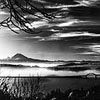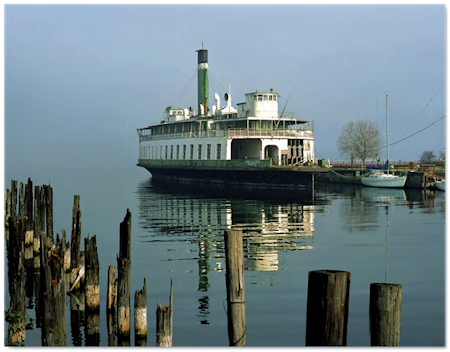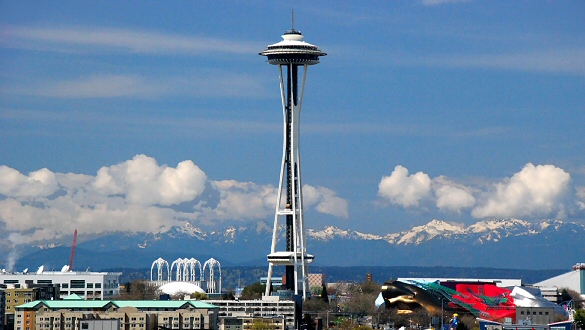Posts Tagged ‘seattle’
Into boats?
Into boats? I am. Here is a link to boats that I have owned, chartered, and crewed on.
36 Foot Ketch on Puget Sound
Before discussing the sailboat, worth identifying are the mountain peaks in the background. These peaks are the higher two peaks of the southern end of the Olympic Mountains of Washington State, a peninsula. First is Mount Ellinor, elevation 5,924 feet (1,805 meters), and to its right is a higher Mount Washington, elevation 6,259 feet (1,908 meters). I used these mountain peaks as an opportunity for a backdrop in order to achieve an enhanced composition for when a boat would pass by. I was rewarded when this beautiful twin-mast sailor with clipper-style hull indeed arrived! This boat, a beautiful sailing ketch, glided smoothly past on the sailing position known as a reach – with wind hitting its port beam. A number (“36”) clearly visible below the peak of the mainsail indicates the length the boat.
Officially Spring in the Pacific Northwest
At the start of spring (spring vernal equinox), day and night are approximately 12 hours long (at the equatorial plane) and the Sun is at the midpoint of the sky. Our north pole tilts towards the Sun. Meteorological determination of spring is calculated according to when the sun passes through the equatorial plane. When going from winter to spring, the sun is moving north; as soon as the sun crosses the equator, we call it spring (northern hemisphere).
Good times ahead!
Source: http://wiki.answers.com
Three Sheets Northwest – About Boating in the Pacific Northwest
 Three Sheets Northwest is the only website providing original news, features and other information updated almost daily that focuses exclusively on boating in the Pacific Northwest.
Three Sheets Northwest is the only website providing original news, features and other information updated almost daily that focuses exclusively on boating in the Pacific Northwest.
Visit ThreeSheetsNW.com now!
Remembering the San Mateo Ferry
Temporarily on the south end of Lake Union, in Seattle, Washington, the “San Mateo Ferry” awaited an uncertain fate. The year was 1987.
A Saturday in 1987 I had planned to attend a programming class to benefit my job at a computer firm. As I was near the location of the class, fog which had covered much of the city that morning was beginning to clear. The sun was beaming through holes in the fog and was lighting up the scene around me. I skipped the programming class to take pictures. This one of the San Mateo Ferry was a result of my effort that day.
Data: “San Mateo” is a steam-ship ferry. Official Number: 222386. Radio Call Letters: WG5465. Built: San Francisco, CA 1922. Length: 230′. Beam: 64′. Draft: 12′ Auto Deck Clearance: 11′ 6″ Speed: 13 knots. Horsepower: 1,400. Propulsion: triple expansion steam engine. Autos: 50 Passengers: 659. Gross Tonnage: 919.
Puget Sound History: In 1947 the San Mateo started on the Seattle-Suquamish route. In 1948 she was moved to the Kingston-Edmonds route for three months, then was placed on reserve. She saw regular service from late sping to early fall between 1952 and 1954 on the Fauntleroy-Vashon run. In 1955 she worked the Bremerton route from June until September. In 1956 she worked as an extra boat on the Kingston-Edmonds route, and then moved back to Fauntleroy-Vashon-Harper in 1957-58. In 1959 she moved back up to Edmonds as an “extra” where she remained until 1969, alternating between Edmonds and the Seattle-Winslow routes. The San Mateo made her final run from Edmonds to Kingston on Labor Day of 1969 and was packed to her limit.
During her time on the Sound the San Mateo Ferry was well-loved. People responded to the sound of her steam engines and whistle, the stained glass windows of her interior, the mahogany pew-like benches in her passenger cabin. Sadly, she now lists in shallow water on the bottom of the lower Frazer River in British Columbia and has decayed beyond reasonable recovery.
Information source: www.evergreenfleet.com/mateo.html
272 Days Since Last Reaching 75 Degrees Fahrenheit
Earthquake: April 29, 1965, 7:28am
Earthquake
Revisiting history when on Thursday Morning, April 29, 1965 at 7:28am, a 6.5 magnitude earthquake occurred between Seattle and Tacoma. This earthquake was among the largest and most damaging earthquakes of the past 100 years in the Pacific Northwest. The quake was felt over nearly 200,000 square miles covering Washington, much of Oregon, Southwest British Columbia, and the Idaho panhandle.
My Account – The Setting
I was in 8th grade at East Junior High School in Puyallup, Washington. I had just finished my last lap in a mile run at the track that was located near the east end of the large field east of the school buildings. Exhausted from my run, I huffed over to the bleachers at the edge of the track to sit and catch my breath.
Short Shockwaves
Just as I was about to relax I heard the loudest noise I had ever heard. It sounded as if a dozen Boeing 707 jet engines were ignited with continuing thunderclaps imbedded in the din. Puyallup is in the Seattle flight line and I feared a jet was crashing near me. I looked around and was surprised to see nothing visible that should cause such a loud roar. Almost simultaneous with the noise, the ground was rapidly and violently shaking. I felt I should flee, but where? I just reasoned that the ground was going to crack open and I would get swallowed into the dirt so I began to run once again.
Medium Shockwaves
Though still exhausted from the mile run, I was running, this time towards the school for I felt I would be safer there. The field I was on was several acres large, and the school was a long way away. I believed I was running for my life. I could not run straight because I was being buffeted back and forth by the rocking ground. It was a frantic run.
Longer Waves
Still running, I witnessed the telephone poles rocking back and forth several yards away from me, and I observed waves underneath moving through the field I was on. The power and phone lines were swinging like jump ropes. The field was looking as if it was liquid; as if it was on top a wavy ocean. I could actually see the direction the waves were moving, west to east.
Quake’s End
Soon I realized that the ground was not going to swallow me up, nor was I going to be called upon to rescue survivors from a catastrophic plane crash and I stopped my run. It was later documented that the quake lasted 45 seconds, but to me it felt as if it shook for minutes. The quake was the only focus of our conversations that day and for some time.
Aftermath
The quake’s epicenter was near Des Moines, Washington, only 15 miles away. Four people lost their lives in Seattle, and there were a fair amount of injuries as a result of the quake. Damage was estimated at over $12 million.
Sources cited: Seismo Archives
1965 Puget Sound (USA) Earthquake Archive | HistoryLink.org
What is the Pacific Northwest? And where is it?
The Pacific Northwest, geographically referred to as Cascadia, is the northwest region of North America, and is bound by the Pacific Ocean. It encompasses all of Washington, Oregon States and Northern California, British Columbia Canada, and Alaska. It is an area of vast beauty. Here you will find multiple climates and topography, from the highest mountains on the continent, to many thousands of miles of coastline, and globally rare inland seas.
 |
Honoring a Pacific Northwest Photographer: Josef Scaylea
 Those of us who have lived in the Pacific Northwest, even if we have not known him by name, have undoubtedly seen the work of Josef Scaylea (1913-2004), perhaps the best known photographer of the region. Mr. Scalea served as chief photographer of the Seattle Times for 35 years. Those of us who have lived in the Pacific Northwest, even if we have not known him by name, have undoubtedly seen the work of Josef Scaylea (1913-2004), perhaps the best known photographer of the region. Mr. Scalea served as chief photographer of the Seattle Times for 35 years. |
Here are the links to explore:
“Classic Northwest Photography” by Josef Scaylea at SeattleGallery.com





